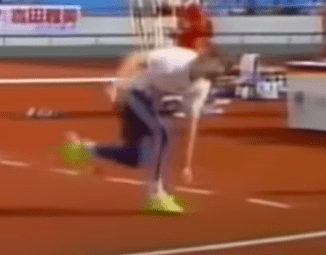
Coming Together
Flexion and extension. Compression and Suspension. There are pairs that govern movement, both globally and locally. The system and its parts act to pull apart and come together. Posture, moving fast, and any sort of training or exercise is versed in this spreading or cinching. Understanding what it is and when it happens can help you experience greater efficiency and effectiveness in whatever you personally practice.
The one-two punch of this realization came from a visit with Adarian Barr and my masseuse, Jim Freda. Adarian brought his new invention with him and we played with and tested them. They are a type of pad that helps whatever is on them to ‘stay put’. In quadraped, it was quite interesting to experience the sensation of the hands and feet coming together versus the butt being pushed away:
The system shifts to move the leg or the system holds and the leg has to work to provide the action.
I learned about the hyoid bone from Jim, and when we chatted in his office pre-massage, he mentioned the static nature of things coming together and the dynamic nature of them coming apart. I was coming in for some neck tension, and have been working on my posture for years. In the car, I often slide my neck fold back and reflexively lift the xiphoid. When I do this, the balance of tone is restored and the head sits instead of tilts:
To emphasize the utility of the mechanism, let’s look at a bicep curl. Hands come toward chest. It can be done with elbows and wrists remaining where they start, or it can be done with elbows moving back and the wrists flexing. One lever or compounding levers. Assistive or resistive. For me, flexing the wrists is the largest influence:
Wrist extension is also incredibly advantageous for me in the bench press.
“Stretching” while stabilizing the system upends the entire concept of what stretching is and should feel like. Instead of pulling apart from distal ends the action happens internally from the joint. Please note that this is not like FRC — there is no excessive tension in the surrounding tissues. The limb feels fastened to the ground, not effortfully attached and working to stay there.
In the following pigeon example, I am again using the pads because I am not familiar with creating this ‘stuck’ sensation without them. Described another way, it almost feels as if there is a wedge stopping each limb placed on top from leaning. For the arm the lat locks in, and for the leg the femur holds the pelvis. The progression goes from regular to knee on pad to hand and knee on pad.
When my face winces I bring the extended leg into flexion and squeeze the down hand armpit toward the dropping hip.
Lastly, when observing athleticism and performance, most point out the explosive extension and separation that occurs with powerful jumping and throwing. But do you watch it all the way through? Have you noticed that long jumpers cycle their arms and legs in the air? And that sprinters do too? And that a spilt second after the world record javelin throw his body looks like this?
The rapid coming together is both the cause and effect of elastic expansion.
Watch the feet of this excellent vertical jumper:
View this post on Instagram
Did you see the heel of his jump off foot keep going toward his butt? Or how the other heel kicked back as his body folded backward? Remember, an opening on one side yields a closing on the other…
How might us mere mortals begin to practice this?
Start with what you already do.
What parts are coming together?
How can you help that along?
A squat example. People understand the lifted leg heel coming to butt because there must be work by the hamstring to complete the movement. But the standing butt to heel is typically done by gravity. The quad ‘braking’ the drop is familiar and successful, so that’s the operation that gets patterned. Getting the standing hamstring to do the same shortening as the lifted hamstring starts to change the experience, acting instead of reacting, pulling together instead of controlling the apart.
View this post on Instagram



